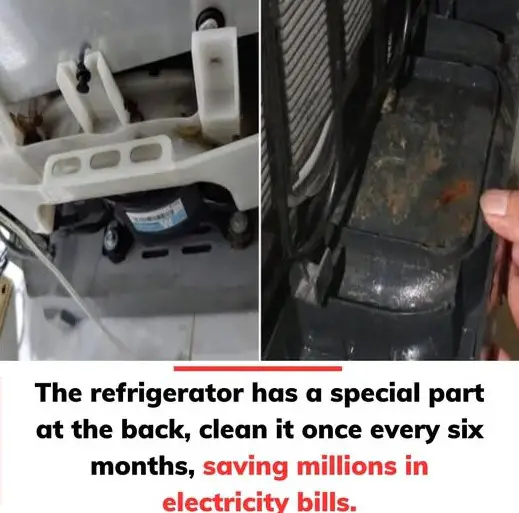In today’s world, where energy costs are a significant concern for households, optimizing the efficiency of our appliances is crucial. The refrigerator, an essential appliance that operates continuously, is a major contributor to household energy consumption. One often overlooked aspect of refrigerator maintenance is the regular cleaning of the condenser coils. Neglecting this simple task can lead to increased energy usage and higher electricity bills.
Understanding the Role of Condenser Coils
Condenser coils are typically located at the back or beneath the refrigerator. They play a vital role in the refrigeration cycle by dissipating heat extracted from the interior compartments. As refrigerant passes through these coils, it releases heat, which is then expelled into the surrounding environment. This process is essential for maintaining the cool temperatures required to preserve food.
The Impact of Dirty Condenser Coils
Over time, condenser coils can accumulate dust, pet hair, and other debris. This buildup acts as an insulating layer, hindering the coils’ ability to release heat efficiently. As a result, the refrigerator’s compressor must work harder and run longer cycles to maintain the desired internal temperature. This increased workload not only accelerates wear and tear on the appliance but also leads to a noticeable uptick in energy consumption.
According to the U.S. Department of Energy, dirty condenser coils can increase refrigerator energy consumption by up to 35%. For households aiming to reduce their electricity bills, this unnecessary energy expenditure is significant.
Benefits of Regular Cleaning
Maintaining clean condenser coils offers several advantages:
- Energy Savings: Clean coils improve heat transfer efficiency, reducing the compressor’s workload and lowering energy consumption.
- Extended Appliance Lifespan: Reduced strain on the compressor and other components can prolong the refrigerator’s operational life, delaying the need for costly replacements.
- Improved Cooling Performance: Efficient heat dissipation ensures that the refrigerator maintains consistent temperatures, preserving food quality and safety.
- Noise Reduction: A less strained compressor operates more quietly, contributing to a more pleasant household environment.
How to Clean Your Refrigerator’s Condenser Coils
Cleaning the condenser coils is a straightforward process that can be completed with minimal tools:
Materials Needed:
- Vacuum cleaner with a brush attachment
- Soft-bristle brush or coil cleaning brush
- Dust mask (optional)
Steps:
- Unplug the Refrigerator: For safety, disconnect the appliance from the power source before beginning any maintenance.
- Locate the Condenser Coils: Refer to your refrigerator’s user manual to find the exact location of the coils. They are usually situated at the back or beneath the unit.
- Access the Coils: If the coils are located behind a removable grille or panel, carefully detach it to expose them.
- Remove Loose Debris: Use the vacuum cleaner with the brush attachment to gently remove loose dust and debris from the coils and surrounding areas.
- Brush Away Stubborn Dirt: Employ the soft-bristle brush to dislodge any caked-on dirt or grime that the vacuum couldn’t remove. Be gentle to avoid damaging the coils.
- Vacuum Again: After brushing, use the vacuum to clean up any remaining debris.
- Reassemble and Restore Power: Replace any panels or grilles that were removed, and plug the refrigerator back into the power outlet.
Frequency of Cleaning
It’s recommended to clean the condenser coils at least twice a year. However, if your household has pets or is located in a particularly dusty environment, more frequent cleanings may be beneficial. Regular maintenance ensures that the refrigerator operates at peak efficiency year-round.
Additional Energy-Saving Tips
While keeping the condenser coils clean is crucial, consider these additional practices to further reduce your refrigerator’s energy consumption:
- Maintain Proper Temperature Settings: Set the refrigerator compartment to 37-40°F (3-4°C) and the freezer to 0°F (-18°C) for optimal efficiency.
- Ensure Adequate Airflow: Avoid overpacking the refrigerator, as proper air circulation is essential for efficient cooling.
- Check Door Seals: Inspect the gaskets around the refrigerator doors to ensure they are sealing properly. Replace any that are worn or damaged to prevent cold air leakage.
- Allow Hot Foods to Cool: Before placing hot leftovers in the refrigerator, let them cool to room temperature to prevent raising the internal temperature and overworking the compressor.
Conclusion
Regular maintenance of your refrigerator’s condenser coils is a simple yet effective strategy to enhance energy efficiency and reduce electricity bills. By incorporating this practice into your household routine, you not only save money but also contribute to a more sustainable environment by reducing energy consumption. Remember, a well-maintained refrigerator operates more efficiently, lasts longer, and provides better performance, making it a win-win situation for both your wallet and the planet.

